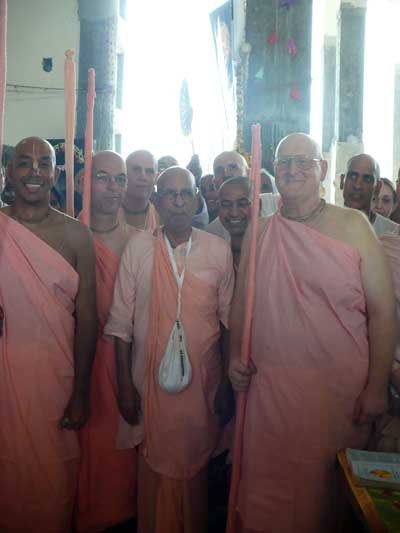Under the guidance of Srila Bhaktivedanta Narayana Gosvami Maharaja, the March 15 – 21 Sri Navadvipa Dhama parikrama was a great success. Over 15,000 pilgrims were gathered at Sri Kesavaji Gaudiya Matha in Koladvipa and all the activities of the parikrama went on smoothly. Even the distribution of 15,000 plates of Sri Krsna prasadam, two or three times a day, went on smoothly – having been arranged by Sri Caitanya Mahaprabhu’s own mother and wife, Srimati Saci devi and Srimati Visnu-priya devi.
The pilgrims visited the prominent holy places in Navadvipa during the daylight hours of the six-day parikrama, and in the evenings they heard the discourses of Srila Narayana Gosvami Maharaja and his followers. Srila Narayana Maharaja would speak for a few minutes about the places visited that day, and then he would call on sannyasis and other speakers to discuss the glories of Sri Caitanya Mahaprabhu and His teachings.
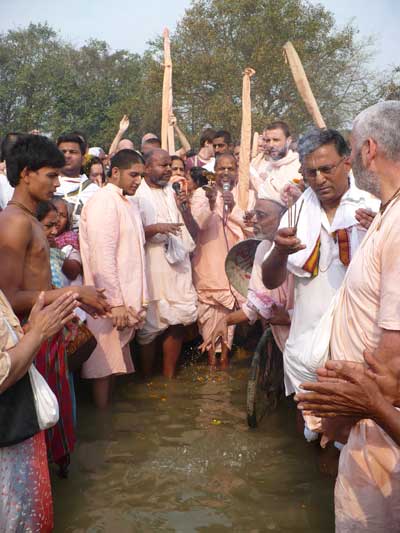
Taking a vow (sankalpa) at the Ganges River on March 15, on the first morning of parikrama.
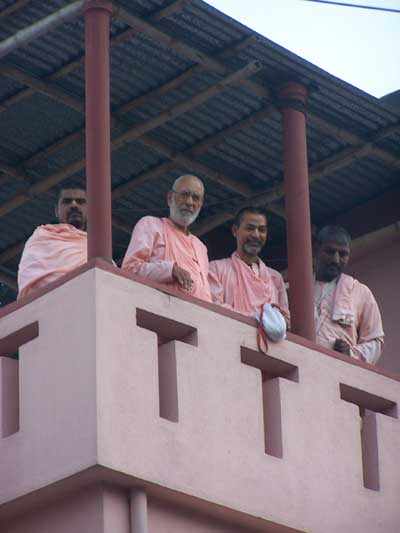
At the beginning of each day’s parikrama, Srila Maharaja stood on the roof of his quarters, watching the pilgrims and giving them his abundant blessings.
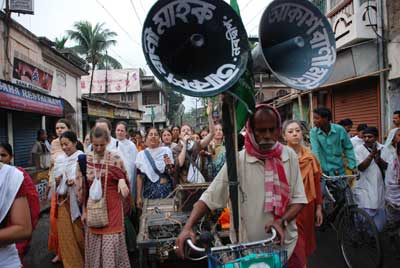
The ladies’ kirtana party
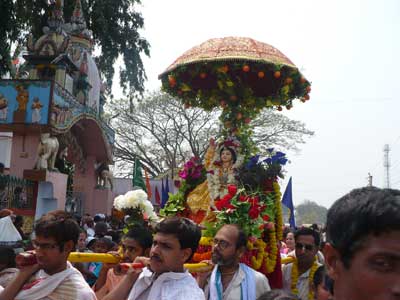
At the head of the entire parikrama party was the Supreme Personality of Godhead, Sri Caitanya Mahaprabhu, carried on a palanquin by His servitors.
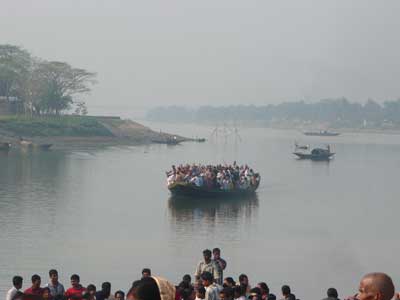
Crossing the Ganga River to Mayapura on March 16, the pilgrims accompanied Sri Caitanya Mahaprabhu to Yogapitha, the Lord’s own birthplace.
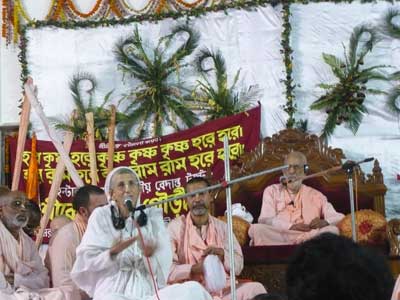
Srila Maharaja called on various speakers each evening, to glorify Sri Caitanya Mahaprabhu, to discuss the reasons for His appearance, and to explain His unique contribution to the world.
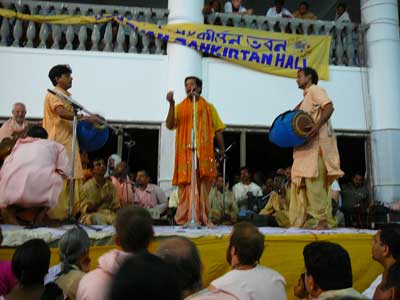
A famous Bengali performance group sings the glories and teachings of Sri Caitanya Mahaprabhu and Sri Krsna.
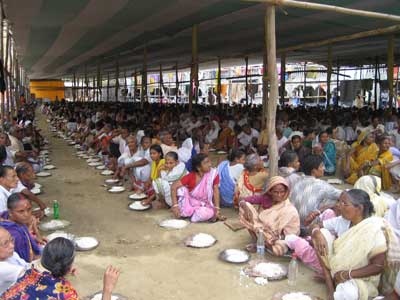
Pilgrims honoring prasadam at Sri Kesavaji Gaudiya Matha
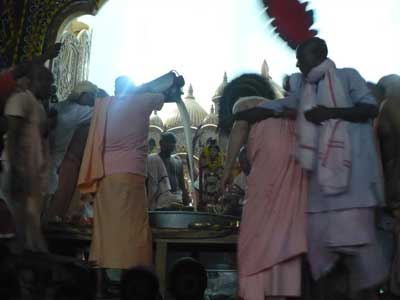
On Gaura-purnima day, March 21, several diksa initiated devotees bathed the Deity of Mahaprabhu with five kinds of auspicious substances, namely honey, yoghurt, milk, ghee, and sugar. This ceremony is called abhiseka.
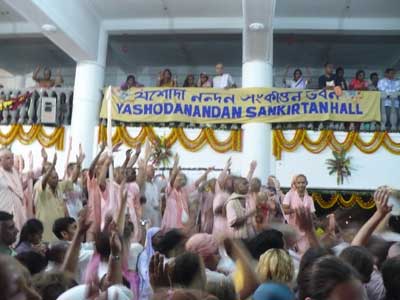
Gaura-purnima kirtana
On March 22, the day following Gaura-purnima, Srila Narayana Maharaja performed a sannyasa initiation ceremony in the temple room of Koladvipa’s Sri Kesavaji Gaudiya Math, and this was his ninth annual sannyasa ceremony. This year and in previous years, he explained that there are two types of sannyasa initiations. The first is the formal initiation of those elevated devotees who were already sannyasa by qualification, and the second is a formal initiation for giving a chance for advancement to those who are not yet qualified. Srila Maharaja also explained that there are two qualifications for sannyasis, and these are described in the following verses. The first is:
trnad api sunicena
taror api sahisnuna
amanina manadena
kirtaniyah sada harih
"One can chant the holy name of the Lord in a humble state of mind, thinking himself lower than the straw in the street. One should be more tolerant than the tree, devoid of all sense of false prestige and ready to offer all respects to others. In such a state of mind one can chant the holy name of the Lord constantly." (Siksastaka 3)
The second is:
vaco vegam manasah krodha-vegam
jihva-vegam udaropastha-vegam
etan vegan yo visaheta dhirah
sarvam apimam prthivim sa sisyat
"One who can control the forces of speech, mind, anger, belly, tongue and genitals is known as a gosvami and is competent to accept disciples all over the world.” (Nectar of Instruction Verse 1)
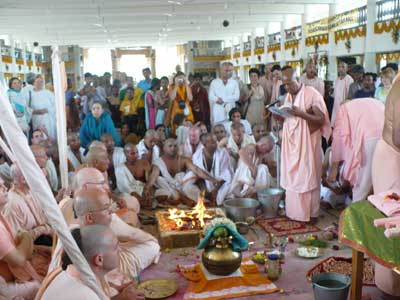
Sannyasa initiation ceremony
The following is a transcription of Srila Narayana Gosvami Maharaja’s short speech at this year’s ceremony:
“Those who are going to take sannyasa should be triguna vijaya. This means they should act in such a way that they will be victorious over the contamination of the three material modes of material nature, namely material goodness, passion, and ignorance. They should be free from lust, anger, greed, illusion, the madness of false pride, and envy (kama, krodha, lobha, moha, mada, and matsarya).
Referring to scripture, Srila Narayana Maharaja explained, “They should be merciful to juniors. They should be niskama. This means they should have the desire to serve only Krsna, Guru, and Vaisnavas. They should give up all other desires. They should be jitendriya. This means they should control their minds and senses.
“I see that some sannyasis do not follow these regulations. They should not be like the Iskcon sannyasis – ninety-five percent of the Iskcon sannyasis fell down. I want that my sannyasis should not fall down during their entire life.
“Not only that, you should be very strong in Krsna consciousness, krsna-bhakti, especially because I have given you the gopi-bhava mantra. Always remember this. Try to forget your worldly name and all worldly designations, such as ‘I am so and so sannyasi’.
“Do not have any interactions with your past family members. Do not go to your native place for at least 12 years. If you are strong after those 12 years, then you can go there. The sannyasa kaupin is Pritivi devi (the goddess of the Earth planet) and the dor (sannyasa under-garment) is Anantadeva, Sesayi Sankarsana. This is given to you so that they will protect you.
“Don’t have any false ego.
“Don’t have any relations with bad persons or sense enjoyers. Try to be merciful to them, but be careful. If you eat their grains or any foodstuffs prepared or offered by them, your heart will be polluted. Don’t have friendship with any sense enjoyers, mayavadis, or those attached to the opposite sex.
“There are two kinds of sannyasis. Those who are really qualified for sannyasa are called vidvadrudhi sannyasis, and the other kind is those who are not qualified. Those who are not really qualified should try to follow all these regulations so that they can become truly qualified in the future.
“Always keep your dor-kaupin and other sannyasa clothing neat and clean. Always keep your cloth colored saffron.
“Do not have any temptation to keep money. If any money is received, at once give it to Gurudeva. He will immediately use it in whatever way he thinks best.”
Srila Narayana Maharaja then asked who is senior (according to the date of their diksa initiation) amongst the three sannyasi candidates: Bhagavata dasa, Jayanta-krsna dasa, and Janardana dasa. He then called on them to stand up, one by one, according to seniority. He first called Sripad Bhagavat dasa vanacari, a senior disciple of Srila Prabhupada Bhaktivedanta Swami Maharaja, and said:
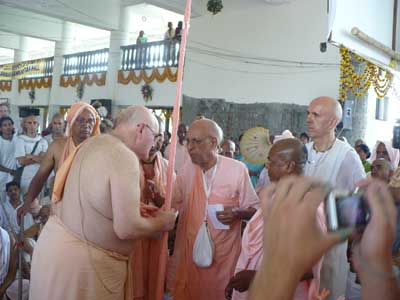
“His name was Bhagavat dasa. I am giving him the name Sri Sriman Bhaktivedanta Bhagavata Maharaja.
“Sri Sriman Bhaktivedanta Bhagavata Maharaja ki jaya, Sri Sriman Bhaktivedanta Bhagavata Maharaja ki jaya, Sri Sriman Bhaktivedanta Bhagavata Maharaja ki jaya.”
Srila Narayana Maharaja then requested Sripad Bhagavat Maharaja to be seated, and he called on Sripad Jayanta-krsna dasa, from France, to stand up:
“Jayanta Krsna prabhu is a very qualified person. He can preach anywhere in so many languages. He was a landlord in a family of kings, but he has left everything. We are now giving him the name Bhaktivedanta Suddhadvaiti Maharaja. Sri Sriman Bhaktivedanta Suddhadvaiti Maharaja ki jaya, Sri Sriman Bhaktivedanta Suddhadvaiti Maharaja ki jaya, Sri Sriman Bhaktivedanta Suddhadvaiti Maharaja.”
Srila Narayana Gosvami Maharaja then called on Sripad Janardana dasa, from Venezuela, to stand up:
“He is a very qualified boy, and he is perfect. His previous name was Janardana brahmacari. Now we are giving him the name Bhaktivedanta Sagar Maharaja.
Sri Sriman Bhaktivedanta Sagar Maharaja ki jaya, Sri Sriman Bhaktivedanta Sagar Maharaja ki jaya, Sri Sriman Bhaktivedanta Sagar Maharaja.”
Srila Narayana Maharaja had given them each their new sannyasa garments and danda at the time of calling them to stand, and now he requested them to change into their new clothes. He requested Sripad Damodara Maharaja to assist them.
